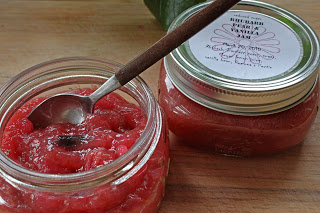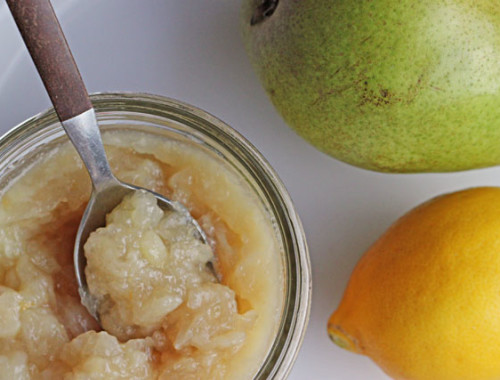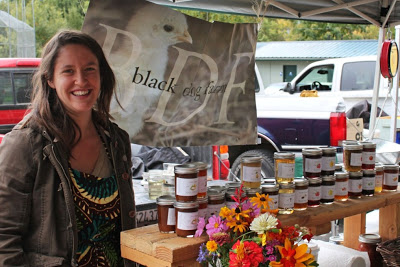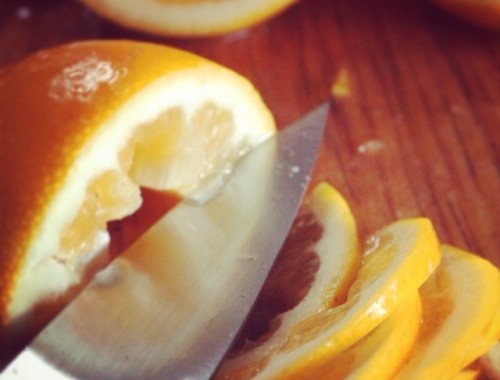I wanted to do something to soothe myself after last week’s garlic disaster. That garlic jelly was a total loss. When Stewart came home from his travels, it took me a whole day just to get him to smell it. When I held out the greenish yellow goo he looked at me like I was offering him a carton of milk that had been in the back of the fridge for three months, asking him, “Will you smell this and tell me if it’s bad?” When he did finally take a sniff, his body lurched backwards, away from the jar. That’s the way I felt about it, too. The entire batch has gone down the sink.
Now it’s time to move on to better things. Sweeter things. A brand new jam.
This is my first-ever rhubarb. At first I wasn’t sure about using it because, well, it’s a vegetable, and I’m always suspicious of a vegetable until it proves to me that it’s friendly. Rhubarb won me over with one bite. It’s more like a fruit in vegetable clothing — those big red stalks only look like rainbow chard on steroids. What a surprising, fruity tart taste!
My choice of main ingredient was also redeeming in Stewart’s eyes. He stood next to me in the kitchen, happily crunching. “I grew up on rhubarb,” he told me. This summer, when we visit his family’s home in way-upstate New York, he promises we can harvest it wild. (I know I’m a jar addict when in March I’m already planning what I’ll can while I’m traveling this summer: Rhubarb in New York. Blueberries, rose hips, and cranberries — both high bush and low bush — in Alaska.)
I adapted this recipe from a book I got at the library last week, Preserving Nature’s Bounty, by Frances Bissell. (It’s out of print, but available used from a variety of sources.) I used Pomona’s Universal Pectin to cut the sugar almost in half. (I learned to make jam from someone who always uses Pomona’s, so that’s what I often do, too. I like the way less sugar lets you taste more fruit.) To determine exactly how much Pomona’s to use, I made a few calculations based on the number of cups of mashed fruit, following the guidelines on Pomona’s packaging insert for “developing your own recipes.” The set turned out great, and I really like the flavor.
It’s worth noting that Pomona’s, used as directed, will often result in a set that looks too soft until the jam is completely cool. (The package insert warns about this, but not in an obvious place.) When I first started making jam with Pomona’s, I freaked out about the soft set more than once, and consequently overdid it on the pectin. That meant the set was too firm and the taste was a bit chalky. Now, I trust the package insert and still my nervous hands. Patience pays off.
Rhubarb, Pear, and Vanilla Jam with Pomona’s Pectin
2 pounds rhubarb, rinsed and cut into 1 inch pieces
6 pears (I used Bartletts), peeled, cored, and sliced
1/2 cup water
1 vanilla bean
1/2 cup lemon juice (I used Meyers)
2 cups sugar to start, adding more to taste
6 teaspoons Pomona’s Pectin calcium water
4 1/2 teaspoons Pomona’s Pectin powder
[Edited to add: The calcium water mix and the pectin powder are both included in the Pomona’s Universal Pectin box.]
Put the rhubarb and pears into your heavy-bottomed, nonreactive pot with the water and simmer until the fruit is soft. (This took a while — at least twenty minutes, maybe more. Sorry, I forgot to set the timer. Toward the end I mushed some of the firmer pieces against the side of the pot with my wooden spoon to help things along.) While the fruit is simmering, measure two cups of sugar into a bowl and thoroughly mix in the pectin powder. Set the sugar and pectin mix aside. Also, have an extra cup of sugar at hand in case you want to make the mix sweeter at the end.
When the fruit is soft, add the lemon juice, vanilla bean, and calcium water to the pot. Stir well and bring to a boil. Mix in the sugar and stir vigorously for a couple of minutes to make sure all the pectin is dissolved. Taste what you’ve got and add more sugar if you like. (I added an extra 1/2 cup here, for a total of 2 1/2 cups of sugar this time.) Return the mixture to a boil and remove it from the heat.
Remove the vanilla bean from the mixture, rinse it, and cut it into pieces. Add one piece to each jar of jam.
I left 1/4 inch headspace and processed ten minutes in a water bath canner.
The original recipe said this would yield 6 half-pint jars (and that was using 4 cups of sugar) but I ended up with 8 half-pints and change. My guess is that this happened because Pomona’s doesn’t require prolonged boiling at the end to achieve a good set, so less liquid evaporates. Sound plausible?
The last thing I want to say is that I’m excited that I finally started to experiment with making my own canning labels. This is a first attempt, playing around with what I had on hand: 2 1/2 inch round labels, an MS Word label template, fonts I like, and a simple rubber stamp. They took fifteen minutes to make and are so much more satisfying than the store-bought kind. (Click here to learn more about how to make them.)






